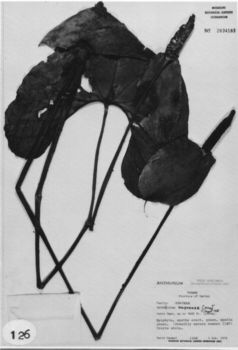




Anthurium sapense Croat, sp. nov.
TYPE: Panama. Darien: Serrania del Sapo, Cerro Sapo, to 1,085 m, ca. 7°41'N, 78°09'W, Hammel 1168 (MO 2634183, holotype; PMA, isotype).
Epiphyte; stems to 1.5 cm diam.; internodes short near apex but quite elongate in lower portion of stem; leaf scars inconspicuous; cataphylls 15-16 cm long, moderately thick, abruptly acuminate at apex, turning reddish brown and persisting intact.
LEAVES with petioles 31-55 cm long, obtusely sulcate; geniculum ca. 1.5 cm long; blades subcoriaceous (dry), ovate-triangular, acuminate at apex, deeply lobed at base, 27-31 cm long, 20-22 cm wide, broadest at the base or at point of petiole attachment; anterior lobe 17-21 cm long, the margins straight to weakly concave, the posterior lobes narrow, broadly curved downward, 12-13 cm long (from apex of sinus to tip of lobe); sinus mostly hippocrepiform when flattened, rounded at apex; both surfaces semiglossy; midrib and basal veins drying raised above, sharply raised below, the basal veins 6 or 7 pairs, the first pair (and sometimes the second pair) free to the base, the third pair coalesced to the higher order veins 2-3 cm, the posterior ribs curved, naked for 4-4.5 cm; primary lateral veins 3 or 4 per side, departing midrib at 60-65° angle, arcuate to the collective vein, drying raised on both surfaces; interprimary veins, secondary and tertiary veins drying prominent; reticulate veins drying prominulous; collective vein arising from one of the lower basal veins, weakly sunken above, prominulous below, 2-6 mm from the margin.
INFLORESCENCE longer than the leaves; peduncles 53-74 cm long, terete, longer than the petioles; spathe white, broadly ovate to obovate, 10-13 cm long, 5.5-7.2 cm wide, broadest usually at middle, caudate at apex (the acumen 2 cm or longer), rounded to cordate and clasping at base; spadix sessile, pink, slightly tapered, bluntly rounded at apex, 7-9 cm long, 7-9 mm diam. at base, ca. 5 mm diam. near apex; flowers rhombic to sub-4-lobed, 1.6-1.8 mm long, 1.7-1.9 mm wide, 8-9 flowers visible in the principal spiral, 12÷14 flowers visible in the alternate spiral, the sides sigmoid; tepals semiglossy, the lateral tepals ca. 1 mm wide, the inner margins drying upturned and concave; pistils not emergent; stamens (dried) possibly retracted; anthers 0.5 mm long, 0.5 mm wide; thecae ovoid, slightly divaricate.
INFRUCTESCENCE with white berries (fide Hammel 1168, not seen). Fig. 126.
Anthurium sapense is endemic to Panama in the Serrania del Sapo in southwestern Daricn Province at about 1,000 m in what was probably premontane rain forest life zone.
The species is a member of section Calomystrium and is unusual for members of this section in being somewhat scandent with the lower internodes elongate (Hammel, pers. comm.). It is also distinguished by its prominently lobed leaves with narrow posterior lobes almost as long as the anterior lobe, its intact, persistent cataphylls, and especially by its broad, white, caudate-acuminate spathe and slightly tapered, pink spadix. This species has no close relatives.
Anthurium sapense is named for the type locality on Cerro Sapo.

DARIEN: Cerro Sapo, Hammel ] 167,7259 (MO), /168 (MO, PMA).